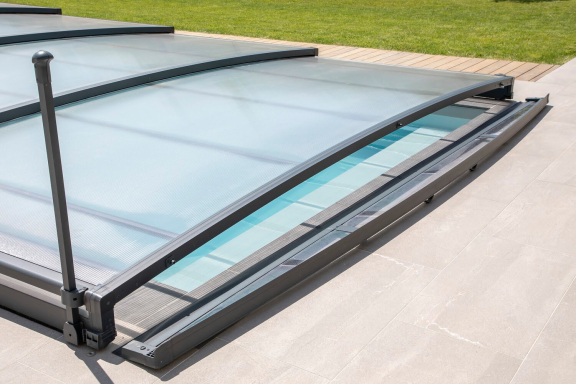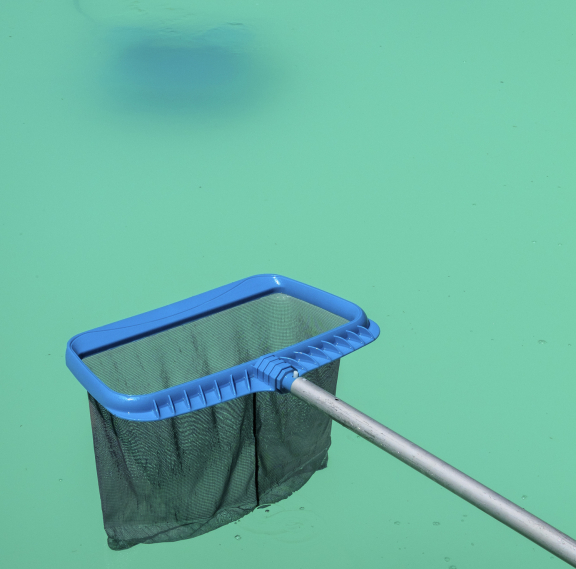Salt electrolysis: everything you need to know concerning your pool
The most common solution to disinfect pool water and ensure that it remains clean and clear is to addchlorine. However, this method has certain disadvantages: it is not eco-friendly, it may cause irritation and it requires the handling of chemical products. One alternative is to treat your pool via salt electrolysis. How does this method work? Here is everything you need to know about the subject.
The operation of a salt electrolysis pool
In the end, a pool with an electrolyser is not very salty. Its water does not resemble seawater and it is in fact chlorine that performs the task of water purification. So, how does it work?
How can salt be transformed into chlorine?
A salt pool uses two elements to create chlorine: sodium chloride and electrical energy. Indeed, when it comes into contact with electricity, salt oxidises and transforms into sodium hypochlorite, or natural chlorine, which becomes active chlorine on contact with water and destroys algae and bacteria.
What is the role of a pool salt electrolyser?
An electrolyser is a device that enables salt to transform into chlorine. It consists of electrodes that create an electrical current that comes into contact with the sodium.
Once the chlorine is in the pool, it is exposed to solar UV rays and returns to the sodium state to return to the electrolyser. Thus, this method follows a perpetual cycle that automatically renews itself.
The advantages and disadvantages of electrolysers
Salt electrolysis is far from being the only method available for the treatment of your pool water. In order to make an informed choice that is truly adapted to your situation, it is important to understand the advantages and disadvantages of this solution.
The advantages of a salt pool
The main advantage of sodium treatment is that it does not require the purchase of chlorine. What specifically does this mean for you on a day-to-day basis? First, you will not have to regularly add chemical products to your pool, so maintenance is simplified. Nor will you need to store chlorine, which is a dangerous product that must be kept out of the reach of children and pets. You will no longer have to handle chlorine, a task which requires a certain amount of precaution, while still benefiting from the effectiveness of this type of product.
Salt treatment is also more eco-friendly, because even if a chemical process still takes place, it does not require the direct use of harmful products. Swimming is also more pleasant because the chlorine created by electrolysis is odourless and does not irritate the skin or eyes.
The disadvantages of salt electrolysers
Nevertheless, sodium treatment does have several disadvantages. It is an economical solution on a daily basis, because you do not need to regularly purchase products, but the cost of installation is quite high. Indeed, it requires a large quantity of salt when launched and, above all, requires the installation of an electrolyser. The installation cost for this type of device can reach up to €2,000.
Electrolysers contain fragile electrodes. This factor must be taken into account in your pool maintenance costs. Electrodes may burn out and require regular replacement. Lastly, salt is corrosive, so it is necessarily to properly clean the electrolyser to prevent damage. The final disadvantage of electrolysers: they become less effective in water temperatures below 16 °C.
How do you install a salt pool?
Installing an electrolyser in a pool is a delicate operation. It is best to use the services of a specialist, who can advise you and safely carry out the installation procedure.
Before installing an electrolyser
Before launching the project, it is important to check several elements to ensure that you choose the best treatment solution and avoid damaging your equipment.
You can thus begin by ensuring that all your pool accessories are suitable for this type of treatment. Salt is corrosive and can damage the stainless steel parts of your equipment.
Then check that your technical room is large enough to house your electrolyser, with its control unit and electrical panel. Finally, you should also make sure that you can easily connect the device to the power mains.
Heat pump, safety rules, connection, etc.: what does installation entail?
The electrolyser must be connected to an earthed socket. It can be installed with a by-pass or in line. The latter is the easiest but less flexible, and the electrodes are more easily damaged. With a by-pass installation, you will be able to close the electrolyser valves, which is practical when the temperature falls below 16 °C and the installation becomes less effective.
Electrolysers are subject to certain safety regulations. They must be placed at least one metre above the ground and protected from water. They are ideally installed near the filter pump.
If you also install a heat pump, it must be placed after the filtration system, but before the electrolyser.

How to correctly use sodium chloride
Salt is a very simple product, but when used for a pool you must pay attention to certain elements. What product should you purchase? What quantity should you use and when should you add more?
What salt should you use for a pool electrolyser?
Salt can be produced in several ways and not all are suitable for use in a pool with an electrolyser. To be sure that your salt is compatible with your electrolyser, search for the EN 16401 – A quality standard.
This standard guarantees that you are using salt that is chemically, physically and micro-biologically pure. Purity is important to guarantee a low concentration of calcium and magnesium. Nor should it contain heavy metals or additives that can damage the pool lining or the electrodes.
The salt for your pool must be compact to ensure that it does not dissolve too quickly in the water to enable the electrolyser to operate more effectively. It may contain stabilising agents to limit photosynthesis, as well as anti-limescale and anti-corrosion agents.
Managing a pool with salt hydrolysis
A salt pool requires the same regular cleaning as a chlorine pool, with a net and a robot cleaner. But what about the treatments to follow to maintain clean, clear water?
Water treatment in a salt electrolysis pool
Your pool water is treated when salt is transformed into chlorine on contact with a hydrolysis device. As chlorine is a powerful algaecide and anti-bacterial agent, it is not necessary to use additional products.
The choice of salt treatment will therefore greatly simplify your pool maintenance because it is not necessary to add salt very often (less often than the chlorine of a more classical pool).
How do you adjust your salt electrolyser?
Pay careful attention to the manufacturer's recommendations when you launch the electrolyser.
When starting, you should add the recommended quantity of salt for your configuration. It is essential to have clean water with a temperature above 15° C and a pH between 7.0 and 7.4 before operating the electrolyser.
When should you run the pool electrolyser?
As the electrolyser is connected to your pool filtration system, it will operate at the same time. To know when to run the electrolyser, you should calculate the required duration of filtration.
This calculation depends on the season because it takes the water temperature into account. Divide the water temperature in your pool by two and you will obtain the necessary daily duration of filtration.
Pay attention to the pH level of a salt pool
An important element for the management of your pool: monitoring the pH level. Indeed, the caustic soda of sodium can easily increase the pH, and a pool with excessively high pH will be more subject to algae and mould.
Therefore, regularly use a pH tester to ensure that you maintain a level between 7.0 and 7.4. The easiest solution to maintain a good level is to install a pH regulator that will make the necessary adjustments.
How do you calculate the quantity of salt for your pool?
To know what quantity to use, you should take into account:
– The volume of pool water in m³ . Apply the following calculation to obtain this volume (for a rectangular pool): Length x width x average depth. Then convert the volume m³ into litres (1 m³ = 1000 litres)
– The salt level required for your electrolyser (generally between 3 and 7 gr/L). You will find this level either in the manufacturer's notice or directly on the device.
Based on this data, you can perform the following calculation: recommended salt dose x pool volume in litres, which will give you the quantity of salt necessary for your pool.

When should you add salt to the electrolyser?
As explained above, electrolysers operate on a perpetual cycle. The salt you add to your pool when commissioning transforms into chlorine, and then back into salt, once again into chlorine, and so on. Therefore, it is not necessary to add salt every week, as you may have to do with the chlorine granules of a more classic pool.
This does not mean that you will never have to adjust the quantity of salt in your pool! Check that the level is still correct once or twice a year. Wintering and recommissioning can be good moments to do this. You can also check the salt level after heavy storms if your pool is not covered.
To test the salt level, simply use the test strips that are available for this purpose. Dip them deep in the water for a few minutes and consult the notice to read the result.
If the salt level is too low, adjust the dose by calculating the difference between the real level and required level (as you did when you launched the electrolyser).
Can you have algae problems with an electrolyser?
Even if the salt electrolyser produces the chlorine that disinfects the pool water, it is not impossible that you will find that your pool has turned green.
Why has my salt pool turned green?
When your pool water becomes cloudy, green, or develops black or mustard-coloured spots, it means that algae have developed in the pool.
The appearance of algae can be caused by:
– Poorly balanced pH. When it comes into contact with salt, the pH of your pool increases, and the higher the pH, the more favourable the environment for the development of algae.
– A poorly adjusted electrolyser. The chlorine generated by the electrolyser has an algaecidal action. But if the electrolyser is poorly adjusted and there is not enough chlorine in the pool, algae may develop.
How do you perform a shock treatment for a salt pool?
When pool water is very dirty or invaded by algae, it may be necessary to carry out a shock treatment. What is the procedure for salt electrolysis?
- Start by carefully cleaning the pool. The walls, the pool bottom, etc. must be brushed briskly to remove algae and dirt.
- Switch off the electrolyser.
- Add commercial chlorine to the pool.
- Clean the filter thoroughly.
- Add a flocculant to eliminate even the smallest particles.
- Allow the filtration system to run for at least 48 hours.
- Restart the electrolyser when your pool water is clean again.
- Check that the pH level of your water is situated between 7.0 and 7.4.
Salt electrolysis offers many advantages for the treatment of pool water, and maintenance is not necessarily more complicated than with another solution, much to the contrary. Before changing your habits and installing costly equipment, consider your needs to identify whether this change will really be worthwhile to you.


